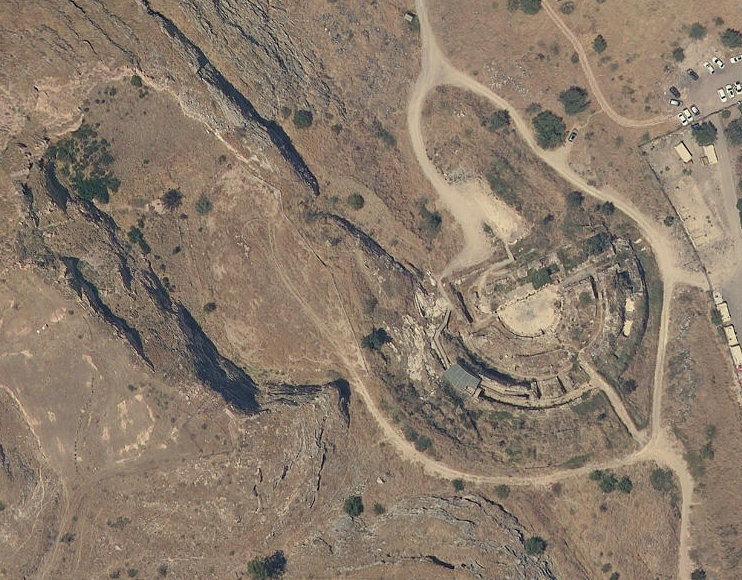Tiberias - Beriniki Theatre
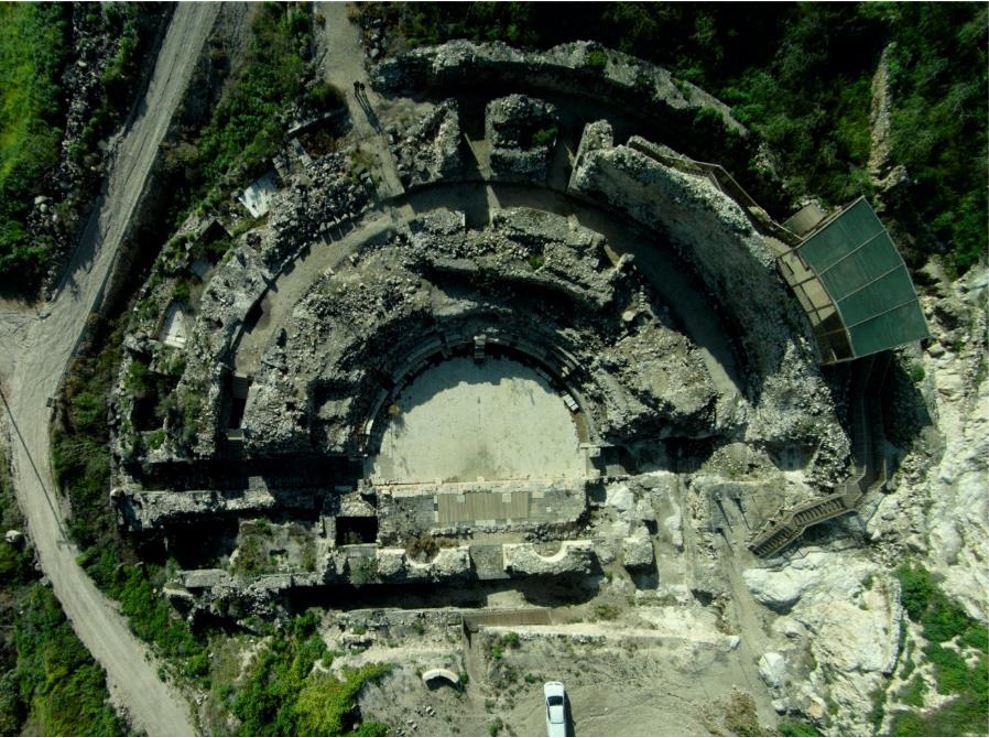 Figure S10
Figure S10Clean version of the drone picture [of Berniki Theater] presented in Figure 4a.
Ferrario et al (2020)
Ferrario et al (2020) report that the Theatre was originally built in the 1st century CE and underwent several modifications in the ensuing centuries,
- from Tiberias - Introduction - click link to open new tab
- Fig. 1 Map of Tiberias
during the Roman period from Atrash (2010)
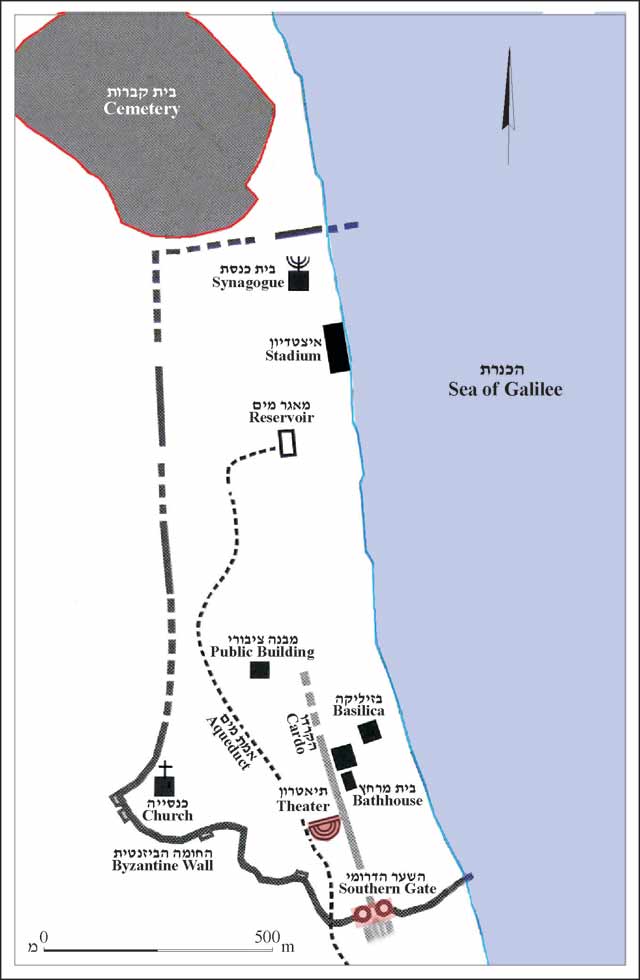
 Figure 1.
Figure 1.
The city during the Roman period, plan (based on Hirschfeld 1992)
Galei Kinneret is next to the Stadium
Atrash (2010)
- Fig. 4 Map of ancient Tiberias
with inferred fault from Ferrario et al (2020)

 Figure 4
Figure 4
Map of ancient Tiberias (modified after Hirschfeld & Gutfeld, 2008) with indication of the inferred lineament and trench position.
Ferrario et al (2020) - Fig. 1b Quaternary faults
around the Sea of Galilee and the Jordan Valley from Ferrario et al (2020)

 Figure 1b
Figure 1b
Quaternary faults in the central part of the DSF, modified after Sneh and Weinberger (2014), Sagy et al. (2016), Hamiel et al. (2016), and Sharon et al. (2018, 2020); the red rectangle is the area enlarged in Fig. 1c
- JVWB: Jordan Valley Western Boundary Fault
- JVF: Jordan Valley Fault
- G: Gilboa Fault
Ferrario et al (2020) - Fig. 1c Simplified geologic map
around the Sea of Galilee along with epicenters of MW > 4.0 events since 1970 from Ferrario et al (2020)

 Figure 1c
Figure 1c
Simplified geologic map (after Bogoch & Sneh, 2008; Sneh, 2008), epicenters of MW > 4.0 events since 1970 (data from http://seis.gii.co.il/en/earthquake/searchEQSRslt.php).
Ferrario et al (2020) - Fig. 10 Sketches of the shallow
subsurface from Ferrario et al (2020)
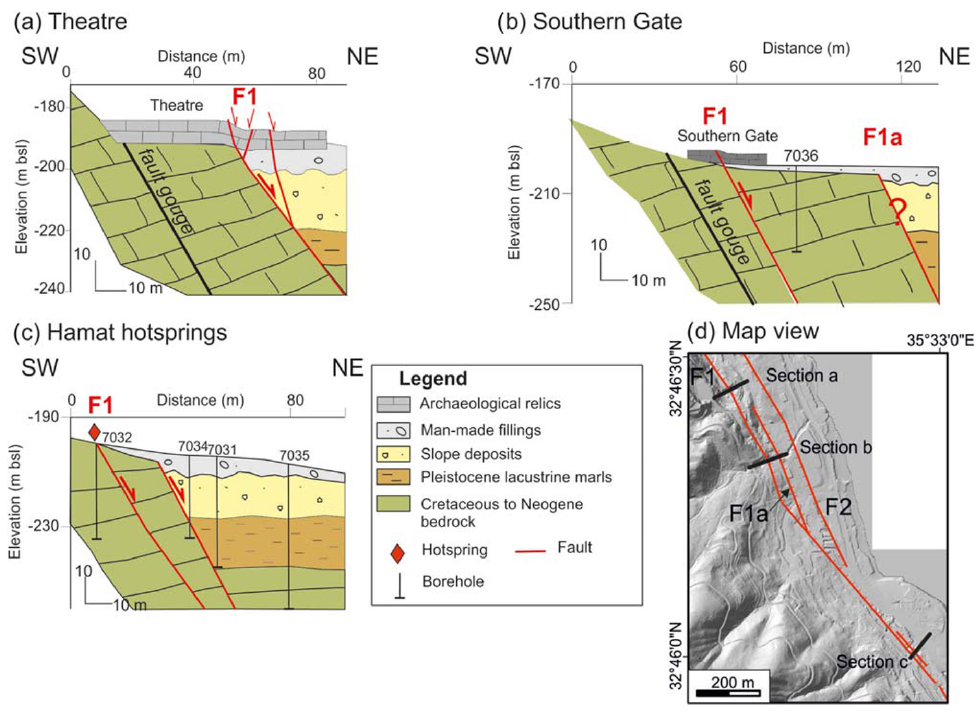
 Figure 10
Figure 10
Schematic sketches of the shallow subsurface at three key positions
- Theater
- Southern Gate
- Hamat hot springs
- section traces
Information on geology is derived from the Israeli geological map (Sneh, 2008), published scientific literature (e.g., Hurwitz et al., 2002), and local reports (e.g., Zaslavsky, 2009). Borehole logs are from GSI archive
Ferrario et al (2020) - Fig. 2b Morphotectonic map
from Ferrario et al (2020)
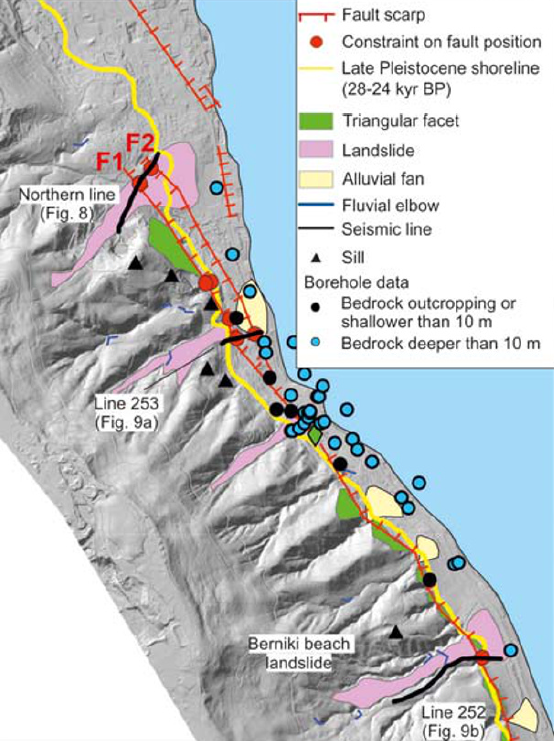
 Figure 2b
Figure 2b
morphotectonic map of the study area, based on 0.5 m resolution DTM extracted from airborne Lidar survey. The map shows also the late Pleistocene shoreline, the position of boreholes analyzed in this study, and the points where we constrained the spatial position of the fault trace.
Ferrario et al (2020) - Fig. 9 Interpreted Seismic
lines from Ferrario et al (2020)

 Figure 9
Figure 9
Seismic lines and relative interpretation
- Southern Gate, location of the trench is also shown
- Berniki Beach landslide
- Traces of the seismic lines
Ferrario et al (2020) - Fig. 8 Interpreted Seismic line
run north of Tiberias Theater from Ferrario et al (2020)
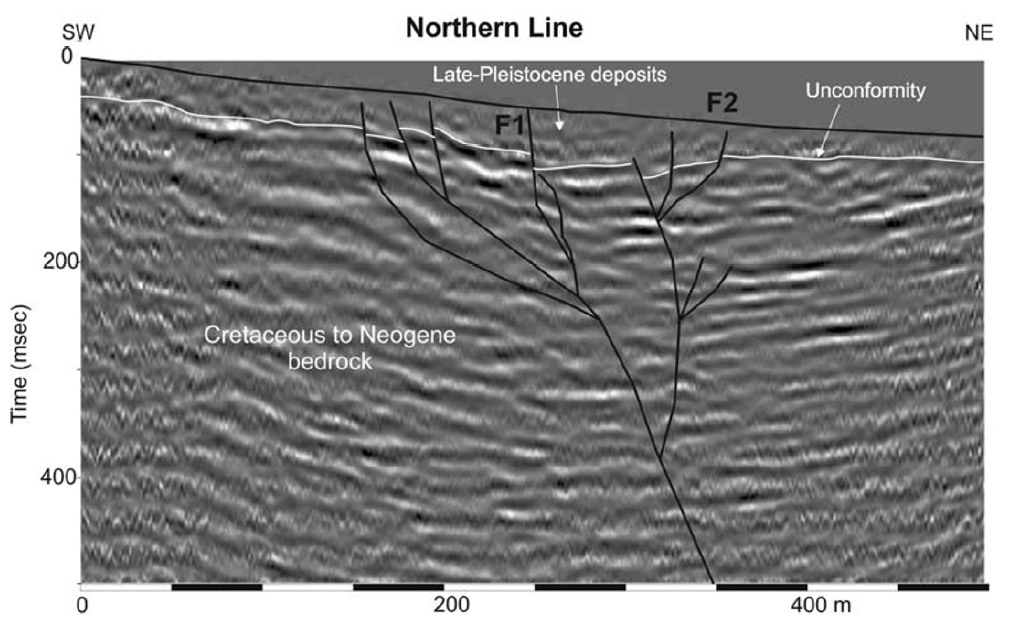
 Figure 8
Figure 8
Seismic line run north of Tiberias Theater and relative interpretation; trace in Figure 9.
Ferrario et al (2020) - Fig. 2a Site Map
from Ferrario et al (2020)
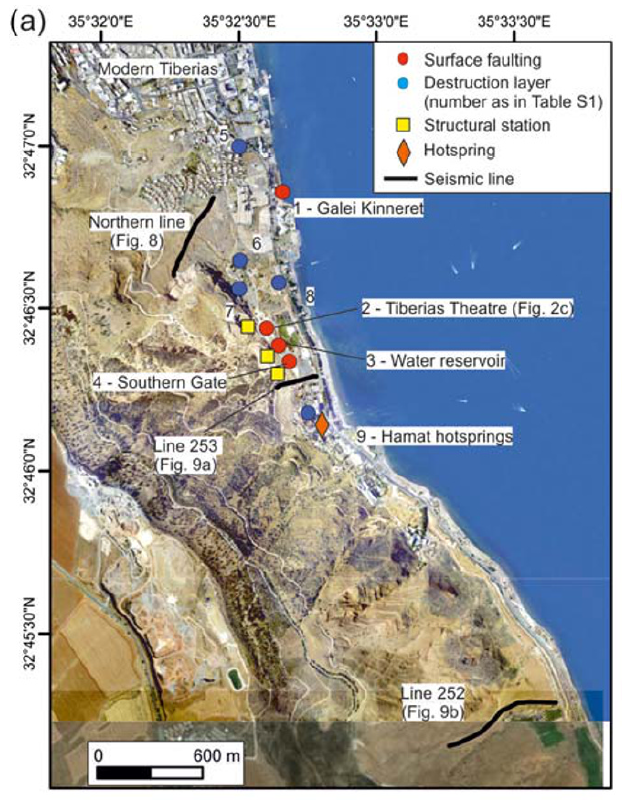
 Figure 2a
Figure 2a
Relevant sites mentioned in the text and location of the seismic lines; numbers correspond to Table S1 in the supporting information where relevant references are provided
Ferrario et al (2020)
- Fig. 1b Quaternary faults
around the Sea of Galilee and the Jordan Valley from Ferrario et al (2020)

 Figure 1b
Figure 1b
Quaternary faults in the central part of the DSF, modified after Sneh and Weinberger (2014), Sagy et al. (2016), Hamiel et al. (2016), and Sharon et al. (2018, 2020); the red rectangle is the area enlarged in Fig. 1c
- JVWB: Jordan Valley Western Boundary Fault
- JVF: Jordan Valley Fault
- G: Gilboa Fault
Ferrario et al (2020) - Fig. 2b Morphotectonic map
from Ferrario et al (2020)

 Figure 2b
Figure 2b
morphotectonic map of the study area, based on 0.5 m resolution DTM extracted from airborne Lidar survey. The map shows also the late Pleistocene shoreline, the position of boreholes analyzed in this study, and the points where we constrained the spatial position of the fault trace.
Ferrario et al (2020) - Fig. 9 Interpreted Seismic
lines from Ferrario et al (2020)

 Figure 9
Figure 9
Seismic lines and relative interpretation
- Southern Gate, location of the trench is also shown
- Berniki Beach landslide
- Traces of the seismic lines
Ferrario et al (2020) - Fig. 8 Interpreted Seismic line
run north of Tiberias Theater from Ferrario et al (2020)

 Figure 8
Figure 8
Seismic line run north of Tiberias Theater and relative interpretation; trace in Figure 9.
Ferrario et al (2020) - Fig. 2a Site Map
from Ferrario et al (2020)

 Figure 2a
Figure 2a
Relevant sites mentioned in the text and location of the seismic lines; numbers correspond to Table S1 in the supporting information where relevant references are provided
Ferrario et al (2020)
- Fig. 4 Map of surface ruptures
in the Beriniki Theatre from Ferrario et al (2020)

 Figure 4.
Figure 4.
Surface faulting at the Tiberias Theatre:
a) map of ruptures across the Theatre, rose diagrams (bin size 15°) show fractures on archaeological relics from the whole site (red, n° 100) and on the orchestra floor (grey, n° 23); picture view angles (the figure number showing each picture is indicated) and trace of total station profiles are shown as well
b-c) details of the gravity graben displacing seat rows and walls
d) right dihedral best fit solution of fault slip inversion (15 fault planes in the limestone bedrock; Table S3)
e) detail of the limestone normal fault gouge (site is shown in a)
Ferrario et al (2020) - Sketch of Tiberias with
the Berniki Theater highlighted in yellow from BibleWalks.com

 Sketch of Tiberias. The Berniki Theater is highlighted in yellow
Sketch of Tiberias. The Berniki Theater is highlighted in yellow
Used with permission from BibleWalks.com - Fig. 3 Theater plan from
Atrash (2010)

 Figure 3
Figure 3
Theater plan
Atrash (2010)
- Fig. 4 Map of surface ruptures
in the Beriniki Theatre from Ferrario et al (2020)

 Figure 4.
Figure 4.
Surface faulting at the Tiberias Theatre:
a) map of ruptures across the Theatre, rose diagrams (bin size 15°) show fractures on archaeological relics from the whole site (red, n° 100) and on the orchestra floor (grey, n° 23); picture view angles (the figure number showing each picture is indicated) and trace of total station profiles are shown as well
b-c) details of the gravity graben displacing seat rows and walls
d) right dihedral best fit solution of fault slip inversion (15 fault planes in the limestone bedrock; Table S3)
e) detail of the limestone normal fault gouge (site is shown in a)
Ferrario et al (2020) - Fig. 3 Theater plan from
Atrash (2010)

 Figure 3
Figure 3
Theater plan
Atrash (2010)
- Fig. D Reconstruction of the
Roman theater from Cytryn-Silverman (2015) and Atrash (2012)

 Figure D
Figure D
Roman theater, reconstruction.
Image courtesy of Walid Atrash, Israel Antiquities Authority.
Caption from Cytryn-Silverman (2015) and image from Atrash (2012)
- Fig. 6 Berniki Theater from
Atrash (2012)

 Figure 6
Figure 6
Berniki Theater, view towards the south
Atrash (2012) - Fig. 6 Berniki Theater with
pink highlighting where downdropped graben has created a fractured zone Atrash (2012)
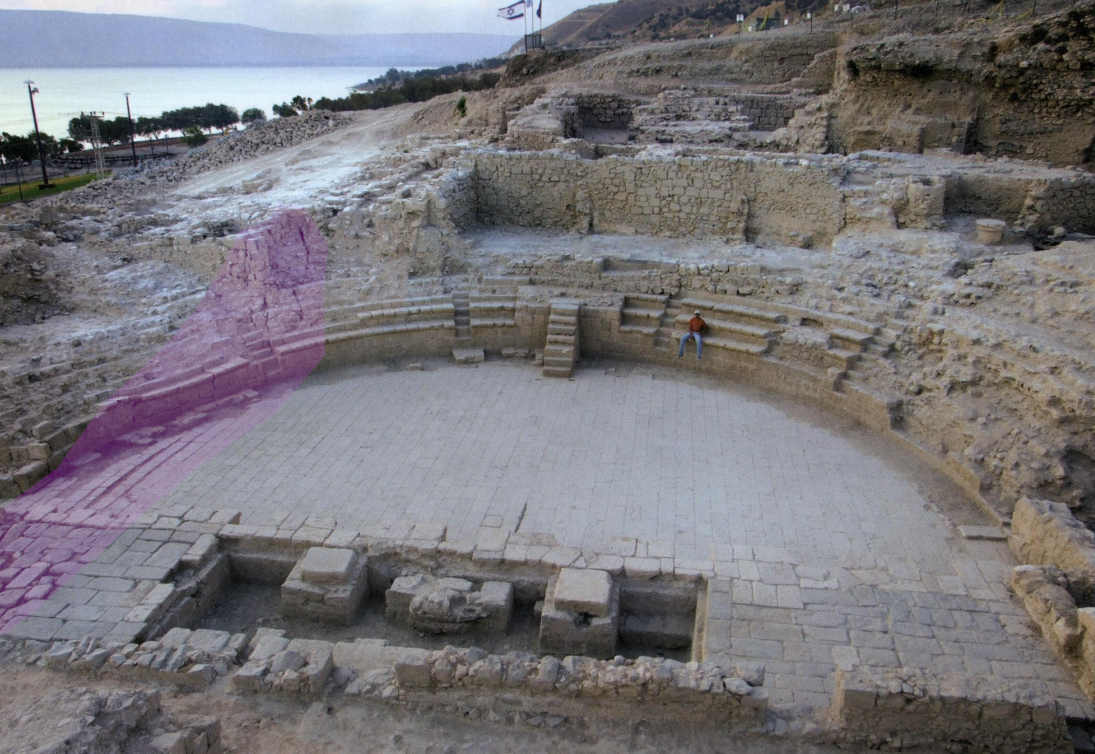
 Figure 6
Figure 6
Berniki Theater (view towards the south) with pink highlighting where downdropped graben has created a fractured zone
Atrash (2012) - Fig. 8 Berniki Theater from
Atrash (2012)
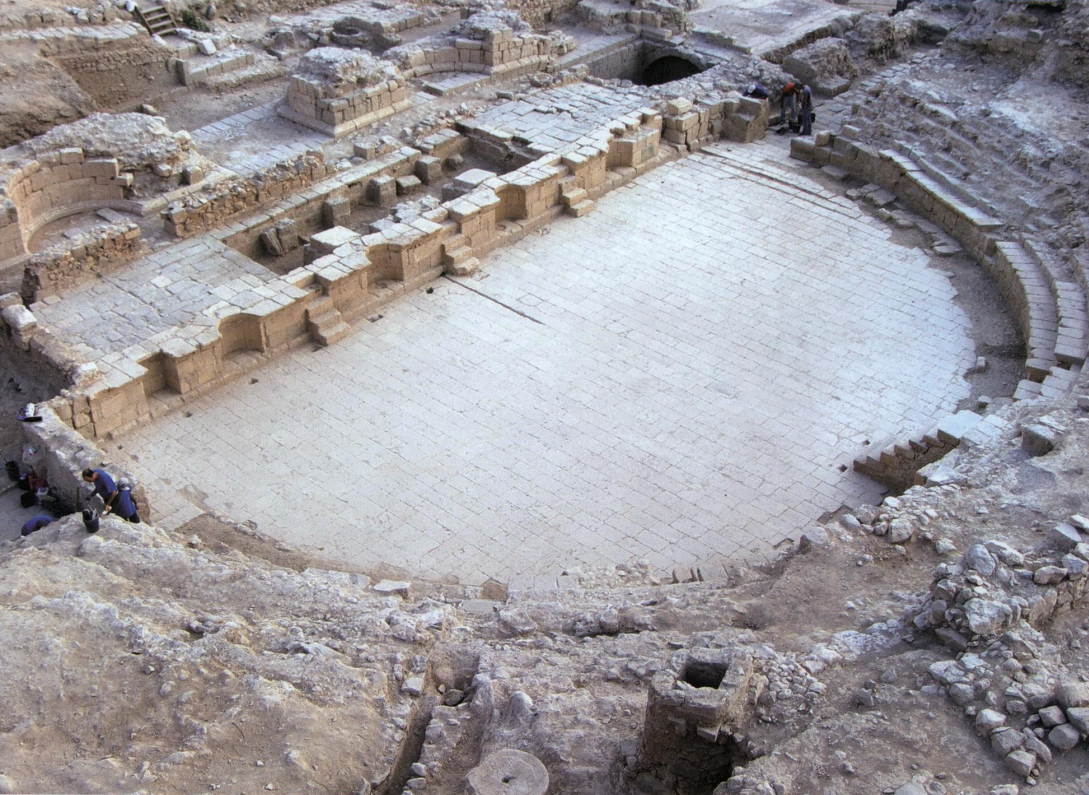
 Figure 8
Figure 8
Berniki Theater, view towards the WSW
Atrash (2012) - Fig. 8 Berniki Theater with
pink highlighting where downdropped graben has created a fractured zone Atrash (2012)

 Figure 8
Figure 8
Berniki Theater (view towards the WSW) with pink highlighting where downdropped graben has created a fractured zone
Atrash (2012)
- from Ferrario et al (2020) citing Atrash (2010)
 Figure 3a) Historical periods in Israel and schematic stratigraphic column at the
Theatre
Figure 3a) Historical periods in Israel and schematic stratigraphic column at the
TheatreFerrario et al (2020)
| Stratum | Period | Date | Notes |
|---|---|---|---|
| I | Late Fatimid | 11th century CE | construction above the collapse caused by an earthquake (in 1033 CE?) |
| II | Early Fatimid | 9th - 10th centuries CE | continued use of the street with shops. |
| III | Abbasid | 8th - 9th centuries CE | a row of shops, the basilica building was renovated. |
| IV | Byzantine–Umayyad | 5th - 7th centuries CE | the eastern wing was added to the basilica building; the paved street; destruction was caused by the earthquake in 749 CE. |
| V | Late Roman | 4th century CE | construction of the basilica complex, as well as the city’s institutions, i. e., the bathhouse and the covered market place. |
| VI | Roman | 2nd - 3rd centuries CE | establishment of the Hadrianeum in the second century CE (temple dedicated to Hadrian that was never completed) and industrial installations; the paving of the cardo and the city’s infrastructure. |
| VII | Early Roman | 1st century CE | founding of Tiberias, construction of the palace with the marble floor on the shore of the Sea of Galilee, opus sectile, fresco. |
| VIII | Hellenistic | 1st - 2nd centuries BCE | fragments of typical pottery vessels (fish plates, Megarian bowls). |
- Fig. 4 Map containing Tiberias
sites studied by Ferrario et al (2020)

 Figure 4: Map of ancient Tiberias (modified after Hirschfeld & Gutfeld, 2008) with indication of the inferred lineament and trench position.
Figure 4: Map of ancient Tiberias (modified after Hirschfeld & Gutfeld, 2008) with indication of the inferred lineament and trench position.
Ferrario et al (2015) - Fig. 4 Map of surface ruptures
in the Beriniki Theatre from Ferrario et al (2020)

 Figure 4.
Figure 4.
Surface faulting at the Tiberias Theatre:
a) map of ruptures across the Theatre, rose diagrams (bin size 15°) show fractures on archaeological relics from the whole site (red, n° 100) and on the orchestra floor (grey, n° 23); picture view angles (the figure number showing each picture is indicated) and trace of total station profiles are shown as well
b-c) details of the gravity graben displacing seat rows and walls
d) right dihedral best fit solution of fault slip inversion (15 fault planes in the limestone bedrock; Table S3)
e) detail of the limestone normal fault gouge (site is shown in a)
Ferrario et al (2020) - Sketch of Tiberias with
the Berniki Theater highlighted in yellow from BibleWalks.com

 Sketch of Tiberias. The Berniki Theater is highlighted in yellow
Sketch of Tiberias. The Berniki Theater is highlighted in yellow
Used with permission from BibleWalks.com - Fig. 3 Theater plan from
Atrash (2010)

 Figure 3
Figure 3
Theater plan
Atrash (2010) - Fig. D Reconstruction of the
Roman theater from Cytryn-Silverman (2015)

 Figure D
Figure D
Roman theater, reconstruction.
Image courtesy of Walid Atrash, Israel Antiquities Authority.
Cytryn-Silverman (2015) - Fig. 5 Fatimid-Abbasid quarter
which was on top of the Roman theater from Atrash (2010)
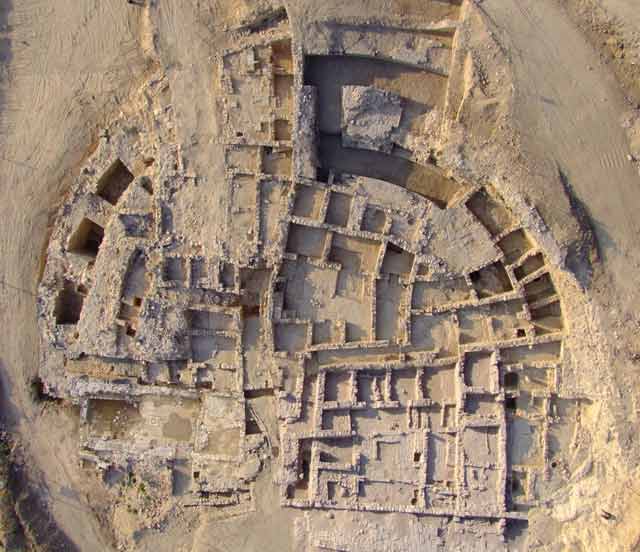
 Figure 5. Residential quarter from the Abbasid period, aerial photograph.
Figure 5. Residential quarter from the Abbasid period, aerial photograph.
Atrash (2010) - Fig. 5 Interpreted photographs
taken during excavations at Tiberias Theatre in 2009 from Ferrario et al (2020)
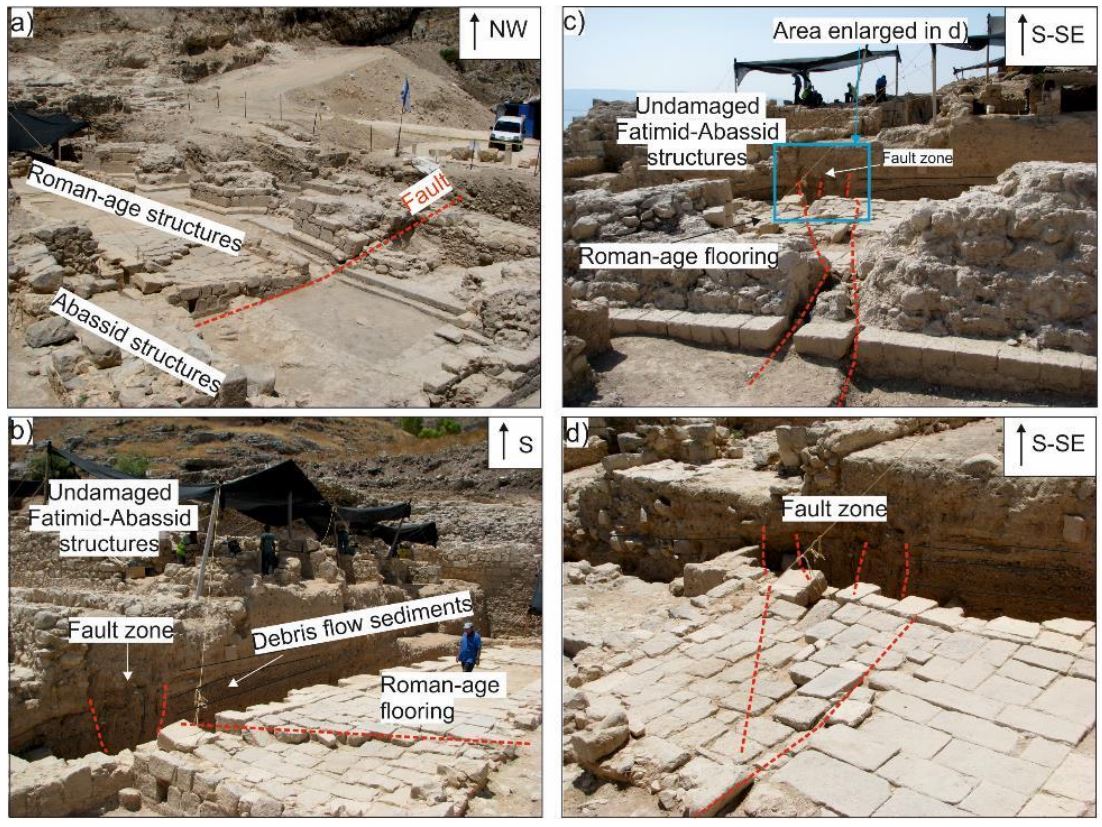
 Figure 5. Interpreted photographs taken during excavations at Tiberias Theatre in 2009
(photo courtesy of S. Marco).
Figure 5. Interpreted photographs taken during excavations at Tiberias Theatre in 2009
(photo courtesy of S. Marco).
a) panoramic view on damaged Roman-age structures (fault trace is marked by red dashed line) overlaid by Fatimid-Abassid undamaged structures
b) damaged Roman Theatre flooring overlaid by faulted alluvial sediments (fault trace is marked by red dashed line) and undamaged Fatimid-Abassid structures
c) damaged Roman Theatre wall, overlaid by faulted alluvial sediments
d) detail of the damaged Roman flooring and the faulted alluvial sediments
Ferrario et al (2020) - Fig. S10 Faulted debris flow
sediments found on top of the theater Ferrario et al (2020)

 Figure S10. Clean version of the photograph presented in Figure 5e. JW: faulted debris flow sediments were uncovered while excavating down to the theater. The debris flows preceded
the earthquake
Figure S10. Clean version of the photograph presented in Figure 5e. JW: faulted debris flow sediments were uncovered while excavating down to the theater. The debris flows preceded
the earthquake
Ferrario et al (2020)
- Fig. 4 Map of surface ruptures
in the Beriniki Theatre from Ferrario et al (2020)

 Figure 4.
Figure 4.
Surface faulting at the Tiberias Theatre:
a) map of ruptures across the Theatre, rose diagrams (bin size 15°) show fractures on archaeological relics from the whole site (red, n° 100) and on the orchestra floor (grey, n° 23); picture view angles (the figure number showing each picture is indicated) and trace of total station profiles are shown as well
b-c) details of the gravity graben displacing seat rows and walls
d) right dihedral best fit solution of fault slip inversion (15 fault planes in the limestone bedrock; Table S3)
e) detail of the limestone normal fault gouge (site is shown in a)
Ferrario et al (2020) - Fig. 3 Theater plan from
Atrash (2010)

 Figure 3
Figure 3
Theater plan
Atrash (2010) - Fig. 5 Interpreted photographs
taken during excavations at Tiberias Theatre in 2009 from Ferrario et al (2020)

 Figure 5. Interpreted photographs taken during excavations at Tiberias Theatre in 2009
(photo courtesy of S. Marco).
Figure 5. Interpreted photographs taken during excavations at Tiberias Theatre in 2009
(photo courtesy of S. Marco).
a) panoramic view on damaged Roman-age structures (fault trace is marked by red dashed line) overlaid by Fatimid-Abassid undamaged structures
b) damaged Roman Theatre flooring overlaid by faulted alluvial sediments (fault trace is marked by red dashed line) and undamaged Fatimid-Abassid structures
c) damaged Roman Theatre wall, overlaid by faulted alluvial sediments
d) detail of the damaged Roman flooring and the faulted alluvial sediments
Ferrario et al (2020) - Fig. S10 Faulted debris flow
sediments found on top of the theater Ferrario et al (2020)

 Figure S10. Clean version of the photograph presented in Figure 5e. JW: faulted debris flow sediments were uncovered while excavating down to the theater. The debris flows preceded
the earthquake
Figure S10. Clean version of the photograph presented in Figure 5e. JW: faulted debris flow sediments were uncovered while excavating down to the theater. The debris flows preceded
the earthquake
Ferrario et al (2020)
Ferrario et al (2020) provided what they characterize as a tight terminus ante quem of
not later than the 8th - 11th century CEfor the damaging event at the Theatre based on overlying structures in the Fatimid-Abassid quarter. These structures, built on top of the Theatre and debris flow deposits which covered the Theater, followed a plan similar to the underlying Theatre (see Fig. 5 from Atrash, 2010). The Fatimid-Abassid structures, which were removed in order to access the Theatre, showed no faulting, damage, or deformation in photographs taken prior to removal. Damage, according to Ferrario et al (2020), was
limited to the Roman-age flooring and to the debris flow sediments above it. Ferrario et al (2020) noted this was particularly evident in the photos in Figures 5 b-d.
A terminus post quem is provided from the Southern Gate area where a deformed Byzantine wall was observed along with presumed vault collapse. According to Procopius1, the Byzantine wall was constructed in the 6th century CE. The collapsed vault was dated to the Umayyad period by Hartal et al. (2010). Hartal et al. (2010) also dated structures built above the presumably collapsed vault to the Abbasid period. Taken together, this constrains the date of the archaeoseismic evidence in the Berniki Theater and the South Gate area to the 7th-10th century.
No radiocarbon dates were reported in the debris flow sediments which can be seen in Figures 5b and S10. A trench was examined near the South Gate site but no earthquake evidence was found in the trench and the trench could not be deepened below the 11th century CE due to the discovery of human remains.
1 Procopius reports in Book V Chapter IX of On the Buildings of Justinian
(trans. Aubrey Stewart - Project Gutenberg) that
Justinian I built the wall of Tiberias
. In the
version of this text translated by Henry Bronson Dewing (available at Topos Text), a margin note dates this "event" to 550 CE.
Justinian I ruled from 527-565 CE.
| Damage Type | Location | Image(s) | Comments |
|---|---|---|---|
| Tilted wall | Site A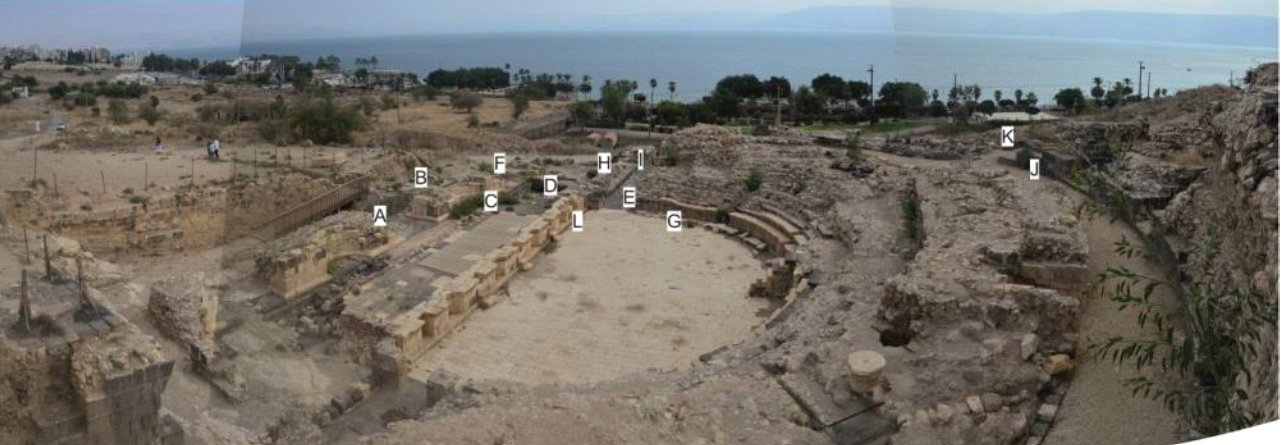
 Figure 6
Figure 6General view of the Berniki theatre (looking NE). The letters show locations of sites. Ferrario et al. (2014) 
 Figure 12
Figure 12Alignment of the observed deformation at the Berniki theatre. Features A,B,C,D,L,G,K are all aligned along a N140° direction, as shown. The dashed red line represents the alignment of the observed damages. Ferrario et al. (2014) |

 Figure 7
Figure 7Deformation observed at the Berniki theatre (Site A). Ferrario et al. (2014) |
|
| Displaced, folded, and tilted wall | Site B
 Figure 6
Figure 6General view of the Berniki theatre (looking NE). The letters show locations of sites. Ferrario et al. (2014) 
 Figure 12
Figure 12Alignment of the observed deformation at the Berniki theatre. Features A,B,C,D,L,G,K are all aligned along a N140° direction, as shown. The dashed red line represents the alignment of the observed damages. Ferrario et al. (2014) |
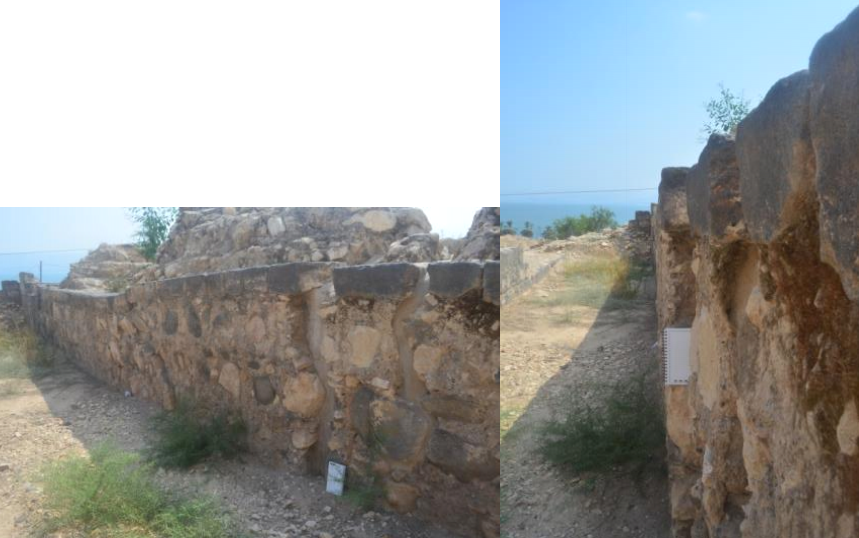
 Figure 8
Figure 8Deformation observed at the Berniki theatre (Site B). Ferrario et al. (2014) |
|
| Fractured wall | Site F
 Figure 6
Figure 6General view of the Berniki theatre (looking NE). The letters show locations of sites. Ferrario et al. (2014) |
|
|
| Tilted wall | Site D
 Figure 6
Figure 6General view of the Berniki theatre (looking NE). The letters show locations of sites. Ferrario et al. (2014) 
 Figure 12
Figure 12Alignment of the observed deformation at the Berniki theatre. Features A,B,C,D,L,G,K are all aligned along a N140° direction, as shown. The dashed red line represents the alignment of the observed damages. Ferrario et al. (2014) |
|
|
| Tilted wall | Site E
 Figure 6
Figure 6General view of the Berniki theatre (looking NE). The letters show locations of sites. Ferrario et al. (2014) |
|
|
| Fractured wall | Site H
 Figure 6
Figure 6General view of the Berniki theatre (looking NE). The letters show locations of sites. Ferrario et al. (2014) |
|
|
| Fractured wall | Site I
 Figure 6
Figure 6General view of the Berniki theatre (looking NE). The letters show locations of sites. Ferrario et al. (2014) |
|
|
| Fractured wall | Site J
 Figure 6
Figure 6General view of the Berniki theatre (looking NE). The letters show locations of sites. Ferrario et al. (2014) |
|
|
| Displaced wall | Site K
 Figure 6
Figure 6General view of the Berniki theatre (looking NE). The letters show locations of sites. Ferrario et al. (2014) 
 Figure 12
Figure 12Alignment of the observed deformation at the Berniki theatre. Features A,B,C,D,L,G,K are all aligned along a N140° direction, as shown. The dashed red line represents the alignment of the observed damages. Ferrario et al. (2014) |

 Figure 10
Figure 10Deformation observed at the Berniki theatre (Site K). Ferrario et al. (2014) |
|
| Tilted and Fractured wall | Site L
 Figure 6
Figure 6General view of the Berniki theatre (looking NE). The letters show locations of sites. Ferrario et al. (2014) 
 Figure 12
Figure 12Alignment of the observed deformation at the Berniki theatre. Features A,B,C,D,L,G,K are all aligned along a N140° direction, as shown. The dashed red line represents the alignment of the observed damages. Ferrario et al. (2014) |

 Figure 11
Figure 11Deformation observed at the Berniki theatre (Site L). Ferrario et al. (2014) |
|
| Fault Gouge | 4e - contact between cretaceous limestones and alluvial sediments NW of the theater
 Figure 4a
Figure 4amap of ruptures across the Theatre, rose diagrams (bin size 15°) show fractures on archaeological relics from the whole site (red, n° 100) and on the orchestra floor (grey, n° 23); picture view angles (the figure number showing each picture is indicated) and trace of total station profiles are shown as well Ferrario et al (2020) 
 Figure 2c
Figure 2cDrone picture of Tiberias Theater (foreground), the outcropping limestone and the modern town (background) photo courtesy of Y. Darvasi Ferrario et al (2020) |
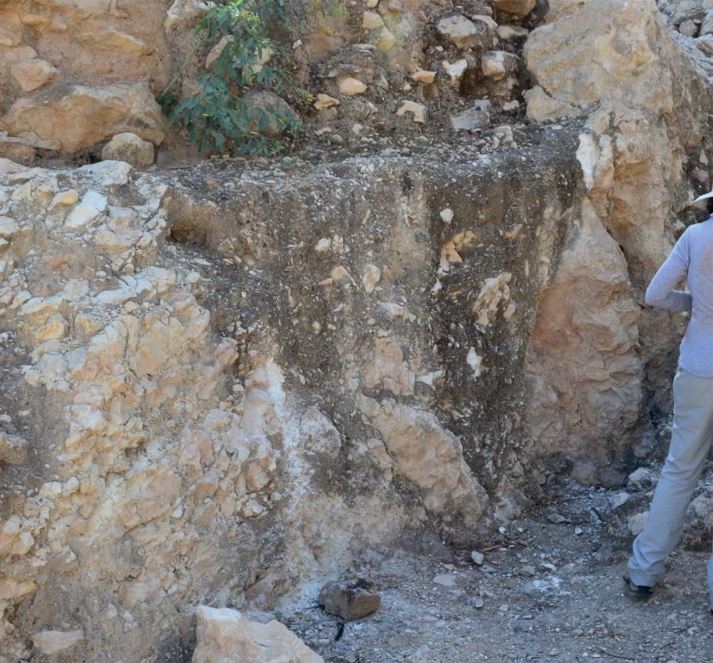
 Figure 4e
Figure 4edetail of the limestone normal fault gouge Ferrario et al (2020) 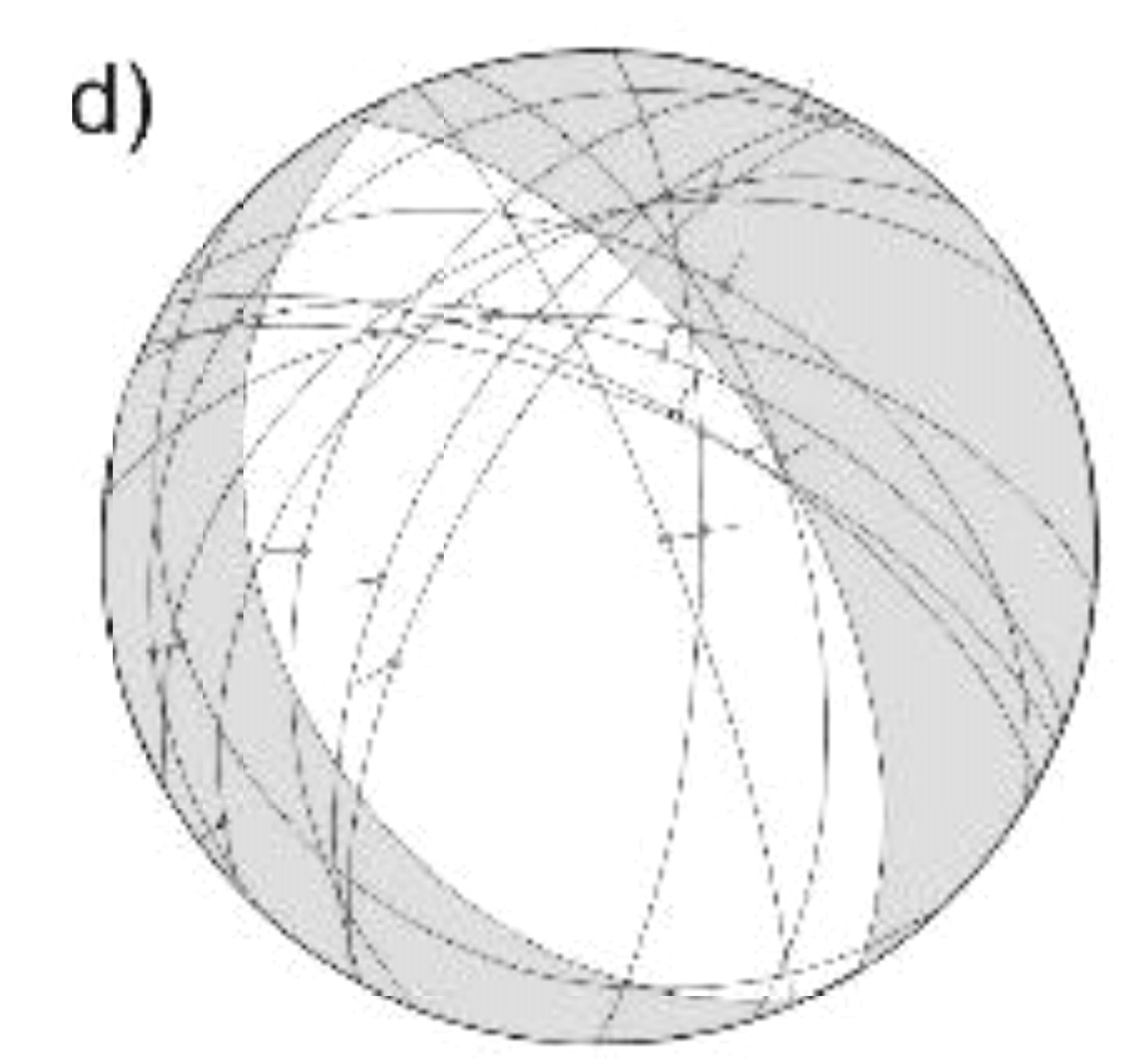
 Figure 4d
Figure 4dright dihedral best fit solution of fault slip inversion (15 fault planes in the limestone bedrock; Table S3) Ferrario et al (2020) |
|
| Displaced and tilted Wall and Gravity Graben | Site G - orchestra limestone pavement and lower block of seats
 Figure 6
Figure 6General view of the Berniki theatre (looking NE). The letters show locations of sites. Ferrario et al. (2014) 
 Figure 4a
Figure 4amap of ruptures across the Theatre, rose diagrams (bin size 15°) show fractures on archaeological relics from the whole site (red, n° 100) and on the orchestra floor (grey, n° 23); picture view angles (the figure number showing each picture is indicated) and trace of total station profiles are shown as well Ferrario et al (2020) 
 Figure 2c
Figure 2cDrone picture of Tiberias Theater (foreground), the outcropping limestone and the modern town (background) photo courtesy of Y. Darvasi Ferrario et al (2020) 
 Figure 12
Figure 12Alignment of the observed deformation at the Berniki theatre. Features A,B,C,D,L,G,K are all aligned along a N140° direction, as shown. The dashed red line represents the alignment of the observed damages. Ferrario et al. (2014) |

 Figure 4b
Figure 4bdetails of the gravity graben displacing seat rows and walls Ferrario et al (2020) 
 Figure 4c
Figure 4cdetails of the gravity graben displacing seat rows and walls Ferrario et al (2020) |
|
| Downfaulting | fault zone going across the theater
 Figure 4a
Figure 4amap of ruptures across the Theatre, rose diagrams (bin size 15°) show fractures on archaeological relics from the whole site (red, n° 100) and on the orchestra floor (grey, n° 23); picture view angles (the figure number showing each picture is indicated) and trace of total station profiles are shown as well Ferrario et al (2020) 
 Figure 2c
Figure 2cDrone picture of Tiberias Theater (foreground), the outcropping limestone and the modern town (background) photo courtesy of Y. Darvasi Ferrario et al (2020) |

 Figure 10
Figure 10Schematic sketches of the shallow subsurface at three key positions
Information on geology is derived from the Israeli geological map (Sneh, 2008), published scientific literature (e.g., Hurwitz et al., 2002), and local reports (e.g., Zaslavsky, 2009). Borehole logs are from GSI archive Ferrario et al (2020) 
 Figure 7
Figure 7a) Topographic profiles obtained with a total station showing the vertical displacement across the studied fault at Tiberias Theatre and the Southern Gate. Each profile is plotted on a relative vertical scale with a vertical exaggeration of ca. 4x b-e) photos of the measured points at Theatre (b-d) and Southern Gate (e), colored dots represent shooting points. Ferrario et al (2020) |
|
| Fractures folds and popups on regular pavements and faulting | fault zone going across the theater
 Figure 4a
Figure 4amap of ruptures across the Theatre, rose diagrams (bin size 15°) show fractures on archaeological relics from the whole site (red, n° 100) and on the orchestra floor (grey, n° 23); picture view angles (the figure number showing each picture is indicated) and trace of total station profiles are shown as well Ferrario et al (2020) 
 Figure 2c
Figure 2cDrone picture of Tiberias Theater (foreground), the outcropping limestone and the modern town (background) photo courtesy of Y. Darvasi Ferrario et al (2020) |

 Figure 5
Figure 5Interpreted photographs taken during excavations at Tiberias Theatre in 2009 (photo courtesy of S. Marco). a) panoramic view on damaged Roman-age structures (fault trace is marked by red dashed line) overlaid by Fatimid-Abassid undamaged structures b) damaged Roman Theatre flooring overlaid by faulted alluvial sediments (fault trace is marked by red dashed line) and undamaged Fatimid-Abassid structures c) damaged Roman Theatre wall, overlaid by faulted alluvial sediments d) detail of the damaged Roman flooring and the faulted alluvial sediments Ferrario et al (2020) 
 Figure S6
Figure S6Clean version of the photograph presented in Figure 5a. Ferrario et al (2020) 
 Figure S7
Figure S7Clean version of the photograph presented in Figure 5b. Ferrario et al (2020) 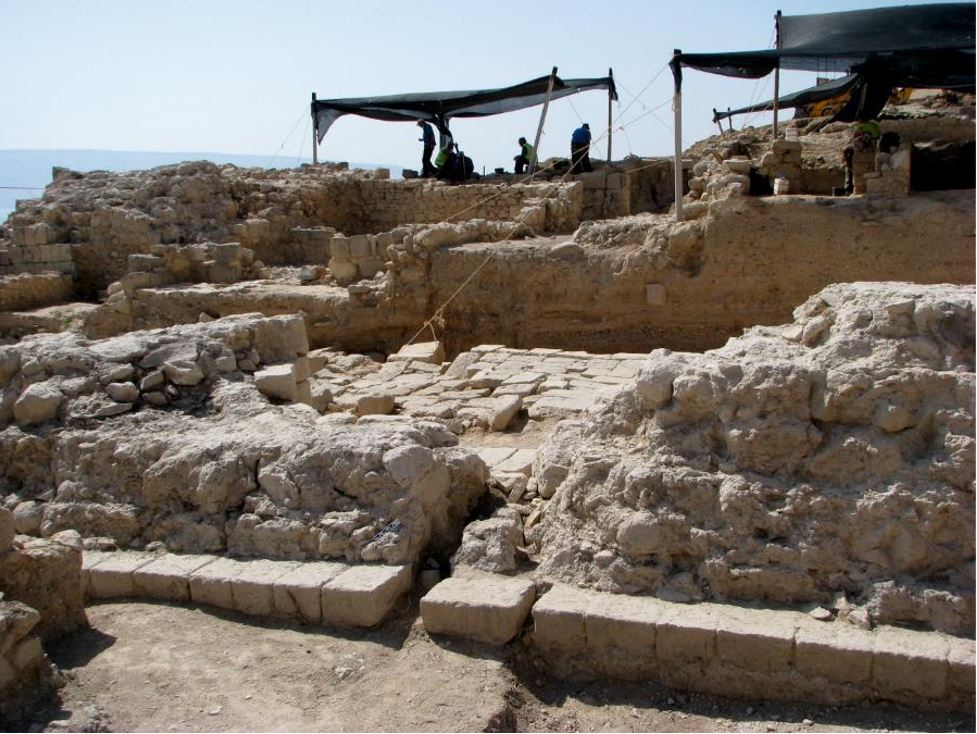
 Figure S8
Figure S8Clean version of the photograph presented in Figure 5c. Ferrario et al (2020) 
 Figure S9
Figure S9Clean version of the photograph presented in Figure 5d. Ferrario et al (2020) |
|
| Faulted Debris flow sediments | On top of the theater - uncovered during excavations down to the Theater
 Figure 4a
Figure 4amap of ruptures across the Theatre, rose diagrams (bin size 15°) show fractures on archaeological relics from the whole site (red, n° 100) and on the orchestra floor (grey, n° 23); picture view angles (the figure number showing each picture is indicated) and trace of total station profiles are shown as well Ferrario et al (2020) 
 Figure 2c
Figure 2cDrone picture of Tiberias Theater (foreground), the outcropping limestone and the modern town (background) photo courtesy of Y. Darvasi Ferrario et al (2020) |
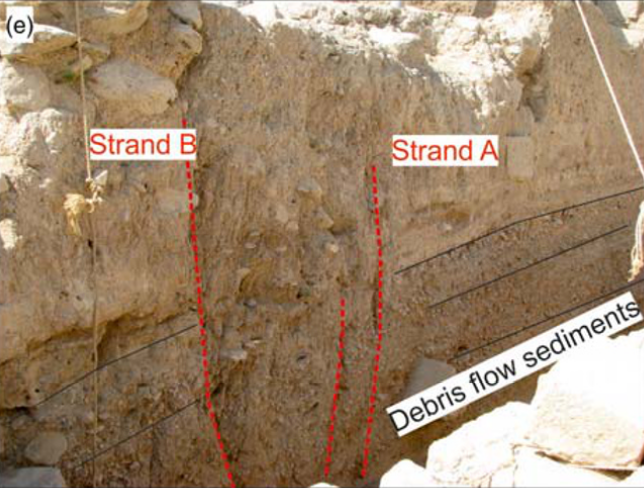
 Figure 5e
Figure 5edetail on the faulted debris flow sediments. Ferrario et al (2020) 
 Figure S10. Clean version of the photograph presented in Figure 5e. JW: faulted debris flow sediments were uncovered while excavating down to the theater. The debris flows preceded
the earthquake
Figure S10. Clean version of the photograph presented in Figure 5e. JW: faulted debris flow sediments were uncovered while excavating down to the theater. The debris flows preceded
the earthquakeFerrario et al (2020) |
|
| Fractures | Theatre |
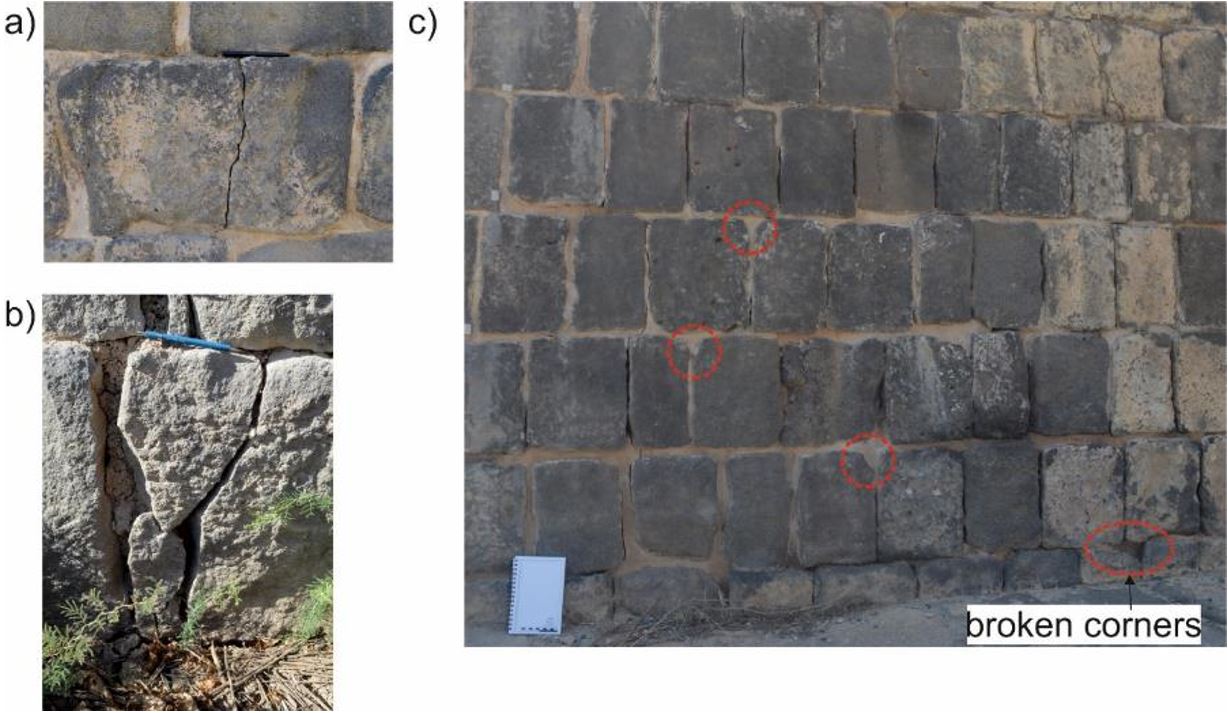
 Figure S14
Figure S14a) example of a fracture affecting a ca. 40-cm high building stone at Tiberias theatre b) fracture affecting a corner of a building stone, Tiberias theatre c) broken corners, Tiberias theatre. Ferrario et al (2020) |
|
| Broken Corners | Theatre | Fig S14

 Figure S14
Figure S14a) example of a fracture affecting a ca. 40-cm high building stone at Tiberias theatre b) fracture affecting a corner of a building stone, Tiberias theatre c) broken corners, Tiberias theatre. Ferrario et al (2020) |
|
- Sketch of Tiberias with
the Berniki Theater highlighted in yellow from BibleWalks.com

 Sketch of Tiberias. The Berniki Theater is highlighted in yellow
Sketch of Tiberias. The Berniki Theater is highlighted in yellow
Used with permission from BibleWalks.com - Fig. 3 Theater plan from
Atrash (2010)

 Figure 3
Figure 3
Theater plan
Atrash (2010) - Fig. D Reconstruction of the
Roman theater from Cytryn-Silverman (2015)

 Figure D
Figure D
Roman theater, reconstruction.
Image courtesy of Walid Atrash, Israel Antiquities Authority.
Cytryn-Silverman (2015) - Fig. 4 Map containing Tiberias
sites studied by Ferrario et al (2020)

 Figure 4
Figure 4
Map of ancient Tiberias (modified after Hirschfeld & Gutfeld, 2008) with indication of the inferred lineament and trench position.
Ferrario et al (2015) - Fig. 4a Map of surface ruptures
in the Beriniki Theatre from Ferrario et al (2020)

 Figure 4a
Figure 4a
map of ruptures across the Theatre, rose diagrams (bin size 15°) show fractures on archaeological relics from the whole site (red, n° 100) and on the orchestra floor (grey, n° 23); picture view angles (the figure number showing each picture is indicated) and trace of total station profiles are shown as well
Ferrario et al (2020) - Fig. 4b Gravity Graben in the
Beriniki Theatre from Ferrario et al (2020)

 Figure 4b
Figure 4b
details of the gravity graben displacing seat rows and walls
Ferrario et al (2020) - Fig. 4c Gravity Graben in the
Beriniki Theatre from Ferrario et al (2020)

 Figure 4c
Figure 4c
details of the gravity graben displacing seat rows and walls
Ferrario et al (2020) - Fig. 4d best fit solution of
fault slip inversion from Ferrario et al (2020)

 Figure 4d
Figure 4d
right dihedral best fit solution of fault slip inversion (15 fault planes in the limestone bedrock; Table S3)
Ferrario et al (2020) - Fig. 4e normal fault gouge
from Ferrario et al (2020)

 Figure 4e
Figure 4e
detail of the limestone normal fault gouge
Ferrario et al (2020) - Fig. 5 Interpreted photographs
taken during excavations at Tiberias Theatre in 2009 from Ferrario et al (2020)

 Figure 5
Figure 5
Interpreted photographs taken during excavations at Tiberias Theatre in 2009 (photo courtesy of S. Marco).
a) panoramic view on damaged Roman-age structures (fault trace is marked by red dashed line) overlaid by Fatimid-Abassid undamaged structures
b) damaged Roman Theatre flooring overlaid by faulted alluvial sediments (fault trace is marked by red dashed line) and undamaged Fatimid-Abassid structures
c) damaged Roman Theatre wall, overlaid by faulted alluvial sediments
d) detail of the damaged Roman flooring and the faulted alluvial sediments
Ferrario et al (2020) - Fig. 7 Vertical displacement
across the inferred fault in Ancient Tiberias from Ferrario et al (2020)

 Figure 7
Figure 7
a) Topographic profiles obtained with a total station showing the vertical displacement across the studied fault at Tiberias Theatre and the Southern Gate. Each profile is plotted on a relative vertical scale with a vertical exaggeration of ca. 4x
b-e) photos of the measured points at Theatre (b-d) and Southern Gate (e), colored dots represent shooting points.
Ferrario et al (2020)
- Fig. 3 Theater plan from
Atrash (2010)

 Figure 3
Figure 3
Theater plan
Atrash (2010) - Fig. 4a Map of surface ruptures
in the Beriniki Theatre from Ferrario et al (2020)

 Figure 4a
Figure 4a
map of ruptures across the Theatre, rose diagrams (bin size 15°) show fractures on archaeological relics from the whole site (red, n° 100) and on the orchestra floor (grey, n° 23); picture view angles (the figure number showing each picture is indicated) and trace of total station profiles are shown as well
Ferrario et al (2020) - Fig. 4b Gravity Graben in the
Beriniki Theatre from Ferrario et al (2020)

 Figure 4b
Figure 4b
details of the gravity graben displacing seat rows and walls
Ferrario et al (2020) - Fig. 4c Gravity Graben in the
Beriniki Theatre from Ferrario et al (2020)

 Figure 4c
Figure 4c
details of the gravity graben displacing seat rows and walls
Ferrario et al (2020) - Fig. 4e normal fault gouge
from Ferrario et al (2020)

 Figure 4e
Figure 4e
detail of the limestone normal fault gouge
Ferrario et al (2020) - Fig. 5 Interpreted photographs
taken during excavations at Tiberias Theatre in 2009 from Ferrario et al (2020)

 Figure 5
Figure 5
Interpreted photographs taken during excavations at Tiberias Theatre in 2009 (photo courtesy of S. Marco).
a) panoramic view on damaged Roman-age structures (fault trace is marked by red dashed line) overlaid by Fatimid-Abassid undamaged structures
b) damaged Roman Theatre flooring overlaid by faulted alluvial sediments (fault trace is marked by red dashed line) and undamaged Fatimid-Abassid structures
c) damaged Roman Theatre wall, overlaid by faulted alluvial sediments
d) detail of the damaged Roman flooring and the faulted alluvial sediments
Ferrario et al (2020) - Fig. 7 Vertical displacement
across the inferred fault in Ancient Tiberias from Ferrario et al (2020)

 Figure 7
Figure 7
a) Topographic profiles obtained with a total station showing the vertical displacement across the studied fault at Tiberias Theatre and the Southern Gate. Each profile is plotted on a relative vertical scale with a vertical exaggeration of ca. 4x
b-e) photos of the measured points at Theatre (b-d) and Southern Gate (e), colored dots represent shooting points.
Ferrario et al (2020)
Cretaceous limestones outcrop in the NW side of the Theatre (Fig. 4a

 Figure 4a) map of ruptures across the Theatre, rose diagrams (bin size 15°) show fractures on archaeological relics from the whole site (red, n°
100) and on the orchestra floor (grey, n° 23); picture view angles (the figure number showing
each picture is indicated) and trace of total station profiles are shown as well
Figure 4a) map of ruptures across the Theatre, rose diagrams (bin size 15°) show fractures on archaeological relics from the whole site (red, n°
100) and on the orchestra floor (grey, n° 23); picture view angles (the figure number showing
each picture is indicated) and trace of total station profiles are shown as well
Ferrario et al (2020)

 Figure 4e) detail of the limestone normal fault gouge
Figure 4e) detail of the limestone normal fault gougeFerrario et al (2020)

 Figure 4d) right dihedral best fit solution of fault slip inversion (15 fault planes in the limestone bedrock; Table S3)
Figure 4d) right dihedral best fit solution of fault slip inversion (15 fault planes in the limestone bedrock; Table S3)Ferrario et al (2020)
The Theatre preserves evidence of damage (Fig. 4a

 Figure 4a) map of ruptures across the Theatre, rose diagrams (bin size 15°) show fractures on archaeological relics from the whole site (red, n°
100) and on the orchestra floor (grey, n° 23); picture view angles (the figure number showing
each picture is indicated) and trace of total station profiles are shown as well
Figure 4a) map of ruptures across the Theatre, rose diagrams (bin size 15°) show fractures on archaeological relics from the whole site (red, n°
100) and on the orchestra floor (grey, n° 23); picture view angles (the figure number showing
each picture is indicated) and trace of total station profiles are shown as well
Ferrario et al (2020)

 Figure 4e) e) detail of the limestone normal fault gouge
Figure 4e) e) detail of the limestone normal fault gougeFerrario et al (2020)

 Figure 4b) details of the gravity graben displacing seat rows and walls
Figure 4b) details of the gravity graben displacing seat rows and walls
Ferrario et al (2020)

 Figure 4c) details of the gravity graben displacing seat rows and walls
Figure 4c) details of the gravity graben displacing seat rows and walls
Ferrario et al (2020)

 Figure 7
Figure 7a) Topographic profiles obtained with a total station showing the vertical displacement across the studied fault at Tiberias Theatre and the Southern Gate. Each profile is plotted on a relative vertical scale with a vertical exaggeration of ca. 4x
b-e) photos of the measured points at Theatre (b-d) and Southern Gate (e), colored dots represent shooting points.
Ferrario et al (2020)
Photos taken in 2009 during the archaeological excavation show that normal displacement affects Roman-age floorings as well as debris flow sediments covering the Theatre pavement (Fig. 5

 Figure 5. Interpreted photographs taken during excavations at Tiberias Theatre in 2009
(photo courtesy of S. Marco).
Figure 5. Interpreted photographs taken during excavations at Tiberias Theatre in 2009
(photo courtesy of S. Marco).a) panoramic view on damaged Roman-age structures (fault trace is marked by red dashed line) overlaid by Fatimid-Abassid undamaged structures
b) damaged Roman Theatre flooring overlaid by faulted alluvial sediments (fault trace is marked by red dashed line) and undamaged Fatimid-Abassid structures
c) damaged Roman Theatre wall, overlaid by faulted alluvial sediments
d) detail of the damaged Roman flooring and the faulted alluvial sediments
Ferrario et al (2020)
- Modified by JW from Fig.s 6 and 8 of Atrash (2012)

 Left
LeftBerniki Theater (view towards the south) with pink highlighting where downdropped graben has created a fractured zone
Modified by JW from Fig. 6 of Atrash (2012)
Right
Berniki Theater (view towards the WSW) with pink highlighting where downdropped graben has created a fractured zone
Modified by JW from Fig. 8 of Atrash (2012)
- Site A
Tilting on a 1.60 m high wall; the wall direction is N50°; fractures and tilting are located in a 5 m long zone, up to 15 cm of spacing between the two sides, later cemented

 Figure 7
Figure 7
Deformation observed at the Berniki theatre (Site A).
Ferrario et al. (2014) - Site B
Fractures and tilting on a 1.70 m high wall; 6 m long zone, up to 25 cm spacing, 10 cm left displacement.

 Figure 8
Figure 8
Deformation observed at the Berniki theatre (Site B).
Ferrario et al. (2014) - Site F Same wall as B but 7 m to the E, here 1.60 m high; fracture in a 2 m long zone, up to 10 cm spacing.
- Site D Tilting in a 4 m high wall, spacing up to 2-3 cm, less clear than previous evidences.
- Site E Tilting in a 2 m high wall, feature similar to D, no spacing nor lateral displacement.
- Site G
Fracture and tilting on a 80 cm high wall; wall direction: N150°, spacing ca. 1 cm.
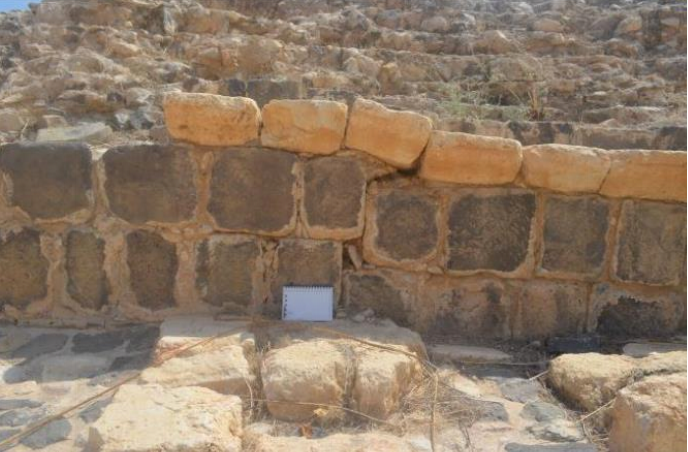
 Figure 9
Figure 9
Deformation observed at the Berniki theatre (Site G).
Ferrario et al. (2014) - Site H Vertical fracture on a 1 m high wall, no spacing nor lateral displacement.
- Site I Fracture on a ca. 4 m high wall, no spacing nor lateral displacement.
- Site J Fracture on a 1 m high wall, spacing max 3 cm, no lateral displacement.
- Site K
Right displacement of 15 cm on two N35° oriented walls, 80 cm high, part of a rectangular structure 3x4 m. Some tilting to the E seems visible on the N wall, but not on the S one (pictures 586-587).

 Figure 10
Figure 10
Deformation observed at the Berniki theatre (Site K).
Ferrario et al. (2014) - Site L
Fractures and tilting on a 1 m long zone, 1 m high wall, spacing up to 10 cm.

 Figure 11
Figure 11
Deformation observed at the Berniki theatre (Site L).
Ferrario et al. (2014) - Site descriptions and photos are from Ferrario et al. (2014)
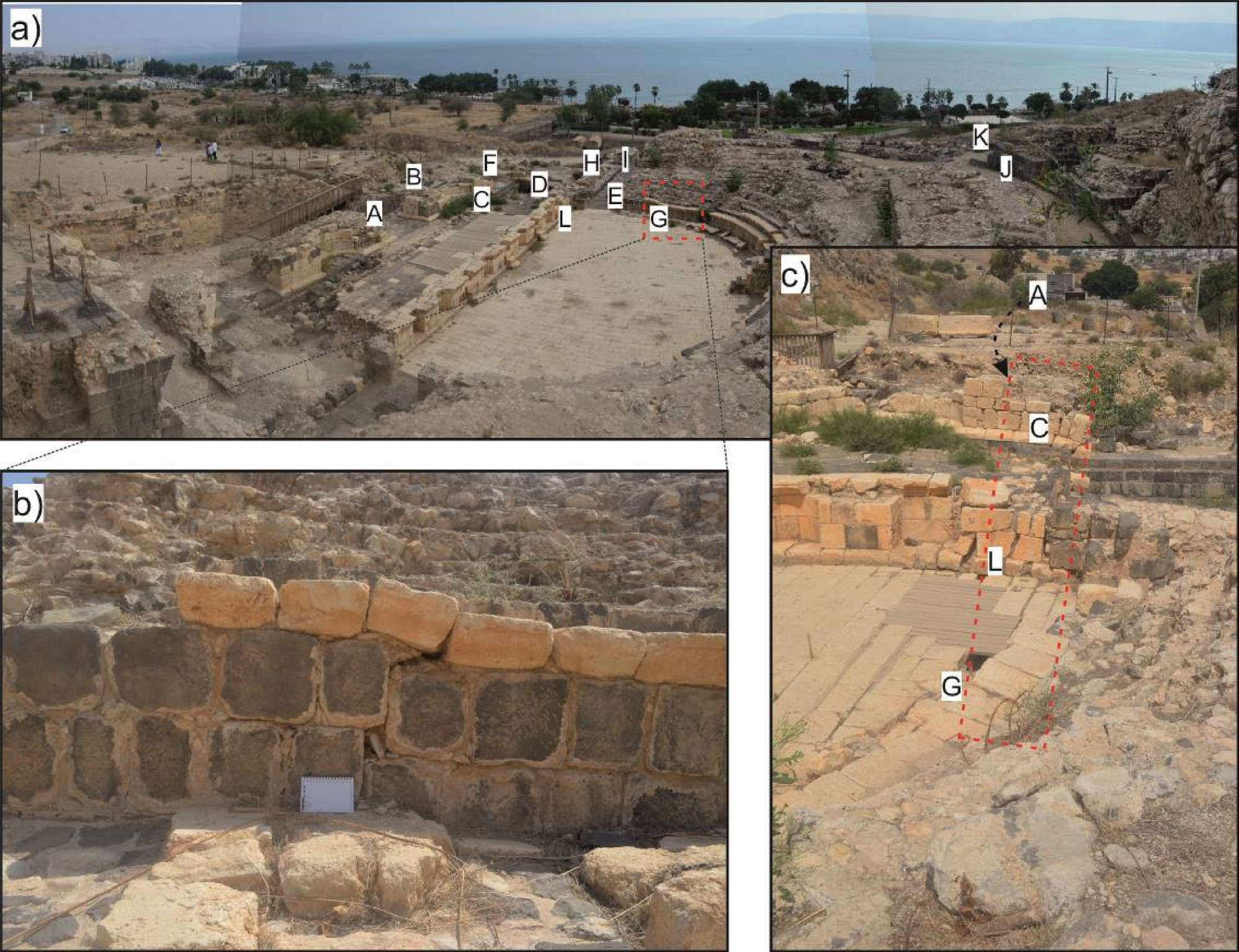 Fig. 3
Fig. 3- General view of the Beriniki theatre (looking NE); the letters show locations of main features
- Detail of an observed deformation
- Alignment of deformations along a N140° direction
Ferrario et al (2020)
 Figure 4: Map of ancient Tiberias (modified after Hirschfeld & Gutfeld, 2008) with indication of the inferred lineament and trench position.
Figure 4: Map of ancient Tiberias (modified after Hirschfeld & Gutfeld, 2008) with indication of the inferred lineament and trench position.Ferrario et al (2020)
- Left - Deformation Map modified by JW from Fig. 3 of Atrash (2010)
- Right - Section from Fig. 10a of Ferrario et al (2020)
 Deformation Map (left)
Deformation Map (left)Modified by JW from Fig. 3 of Atrash (2010)
Section (right)
from Fig. 10a of Ferrario et al (2020)
- Earthquake Archeological Effects chart
of Rodríguez-Pascua et al (2013: 221-224)

 Earthquake Archeological Effects (EAE)
Earthquake Archeological Effects (EAE)
Rodríguez-Pascua et al (2013: 221-224)
| Damage Type | Location | Image(s) | Comments | Intensity |
|---|---|---|---|---|
| Tilted wall | Site A
 Figure 6
Figure 6General view of the Berniki theatre (looking NE). The letters show locations of sites. Ferrario et al. (2014) 
 Figure 12
Figure 12Alignment of the observed deformation at the Berniki theatre. Features A,B,C,D,L,G,K are all aligned along a N140° direction, as shown. The dashed red line represents the alignment of the observed damages. Ferrario et al. (2014) |

 Figure 7
Figure 7Deformation observed at the Berniki theatre (Site A). Ferrario et al. (2014) |
|
VI + |
| Displaced, folded, and tilted wall | Site B
 Figure 6
Figure 6General view of the Berniki theatre (looking NE). The letters show locations of sites. Ferrario et al. (2014) 
 Figure 12
Figure 12Alignment of the observed deformation at the Berniki theatre. Features A,B,C,D,L,G,K are all aligned along a N140° direction, as shown. The dashed red line represents the alignment of the observed damages. Ferrario et al. (2014) |

 Figure 8
Figure 8Deformation observed at the Berniki theatre (Site B). Ferrario et al. (2014) |
|
VII + |
| Fractured wall | Site F
 Figure 6
Figure 6General view of the Berniki theatre (looking NE). The letters show locations of sites. Ferrario et al. (2014) |
|
VI + | |
| Tilted wall | Site D
 Figure 6
Figure 6General view of the Berniki theatre (looking NE). The letters show locations of sites. Ferrario et al. (2014) 
 Figure 12
Figure 12Alignment of the observed deformation at the Berniki theatre. Features A,B,C,D,L,G,K are all aligned along a N140° direction, as shown. The dashed red line represents the alignment of the observed damages. Ferrario et al. (2014) |
|
VI + | |
| Tilted wall | Site E
 Figure 6
Figure 6General view of the Berniki theatre (looking NE). The letters show locations of sites. Ferrario et al. (2014) |
|
VI + | |
| Fractured wall | Site H
 Figure 6
Figure 6General view of the Berniki theatre (looking NE). The letters show locations of sites. Ferrario et al. (2014) |
|
VI + | |
| Fractured wall | Site I
 Figure 6
Figure 6General view of the Berniki theatre (looking NE). The letters show locations of sites. Ferrario et al. (2014) |
|
VI + | |
| Fractured wall | Site J
 Figure 6
Figure 6General view of the Berniki theatre (looking NE). The letters show locations of sites. Ferrario et al. (2014) |
|
VI + | |
| Displaced wall | Site K
 Figure 6
Figure 6General view of the Berniki theatre (looking NE). The letters show locations of sites. Ferrario et al. (2014) 
 Figure 12
Figure 12Alignment of the observed deformation at the Berniki theatre. Features A,B,C,D,L,G,K are all aligned along a N140° direction, as shown. The dashed red line represents the alignment of the observed damages. Ferrario et al. (2014) |

 Figure 10
Figure 10Deformation observed at the Berniki theatre (Site K). Ferrario et al. (2014) |
|
VII + |
| Tilted and Fractured wall | Site L
 Figure 6
Figure 6General view of the Berniki theatre (looking NE). The letters show locations of sites. Ferrario et al. (2014) 
 Figure 12
Figure 12Alignment of the observed deformation at the Berniki theatre. Features A,B,C,D,L,G,K are all aligned along a N140° direction, as shown. The dashed red line represents the alignment of the observed damages. Ferrario et al. (2014) |

 Figure 11
Figure 11Deformation observed at the Berniki theatre (Site L). Ferrario et al. (2014) |
|
VI + |
| Fault Gouge | 4e - contact between cretaceous limestones and alluvial sediments NW of the theater
 Figure 4a
Figure 4amap of ruptures across the Theatre, rose diagrams (bin size 15°) show fractures on archaeological relics from the whole site (red, n° 100) and on the orchestra floor (grey, n° 23); picture view angles (the figure number showing each picture is indicated) and trace of total station profiles are shown as well Ferrario et al (2020) 
 Figure 2c
Figure 2cDrone picture of Tiberias Theater (foreground), the outcropping limestone and the modern town (background) photo courtesy of Y. Darvasi Ferrario et al (2020) |

 Figure 4e
Figure 4edetail of the limestone normal fault gouge Ferrario et al (2020) 
 Figure 4d
Figure 4dright dihedral best fit solution of fault slip inversion (15 fault planes in the limestone bedrock; Table S3) Ferrario et al (2020) |
|
? |
| Displaced and tilted Wall and Gravity Graben | Site G - orchestra limestone pavement and lower block of seats
 Figure 6
Figure 6General view of the Berniki theatre (looking NE). The letters show locations of sites. Ferrario et al. (2014) 
 Figure 4a
Figure 4amap of ruptures across the Theatre, rose diagrams (bin size 15°) show fractures on archaeological relics from the whole site (red, n° 100) and on the orchestra floor (grey, n° 23); picture view angles (the figure number showing each picture is indicated) and trace of total station profiles are shown as well Ferrario et al (2020) 
 Figure 2c
Figure 2cDrone picture of Tiberias Theater (foreground), the outcropping limestone and the modern town (background) photo courtesy of Y. Darvasi Ferrario et al (2020) 
 Figure 12
Figure 12Alignment of the observed deformation at the Berniki theatre. Features A,B,C,D,L,G,K are all aligned along a N140° direction, as shown. The dashed red line represents the alignment of the observed damages. Ferrario et al. (2014) |

 Figure 4b
Figure 4bdetails of the gravity graben displacing seat rows and walls Ferrario et al (2020) 
 Figure 4c
Figure 4cdetails of the gravity graben displacing seat rows and walls Ferrario et al (2020) |
|
VII + |
| Downfaulting | fault zone going across the theater
 Figure 4a
Figure 4amap of ruptures across the Theatre, rose diagrams (bin size 15°) show fractures on archaeological relics from the whole site (red, n° 100) and on the orchestra floor (grey, n° 23); picture view angles (the figure number showing each picture is indicated) and trace of total station profiles are shown as well Ferrario et al (2020) 
 Figure 2c
Figure 2cDrone picture of Tiberias Theater (foreground), the outcropping limestone and the modern town (background) photo courtesy of Y. Darvasi Ferrario et al (2020) |

 Figure 10
Figure 10Schematic sketches of the shallow subsurface at three key positions
Information on geology is derived from the Israeli geological map (Sneh, 2008), published scientific literature (e.g., Hurwitz et al., 2002), and local reports (e.g., Zaslavsky, 2009). Borehole logs are from GSI archive Ferrario et al (2020) 
 Figure 7
Figure 7a) Topographic profiles obtained with a total station showing the vertical displacement across the studied fault at Tiberias Theatre and the Southern Gate. Each profile is plotted on a relative vertical scale with a vertical exaggeration of ca. 4x b-e) photos of the measured points at Theatre (b-d) and Southern Gate (e), colored dots represent shooting points. Ferrario et al (2020) |
|
VI + |
| Fractures folds and popups on regular pavements and faulting | fault zone going across the theater
 Figure 4a
Figure 4amap of ruptures across the Theatre, rose diagrams (bin size 15°) show fractures on archaeological relics from the whole site (red, n° 100) and on the orchestra floor (grey, n° 23); picture view angles (the figure number showing each picture is indicated) and trace of total station profiles are shown as well Ferrario et al (2020) 
 Figure 2c
Figure 2cDrone picture of Tiberias Theater (foreground), the outcropping limestone and the modern town (background) photo courtesy of Y. Darvasi Ferrario et al (2020) |

 Figure 5
Figure 5Interpreted photographs taken during excavations at Tiberias Theatre in 2009 (photo courtesy of S. Marco). a) panoramic view on damaged Roman-age structures (fault trace is marked by red dashed line) overlaid by Fatimid-Abassid undamaged structures b) damaged Roman Theatre flooring overlaid by faulted alluvial sediments (fault trace is marked by red dashed line) and undamaged Fatimid-Abassid structures c) damaged Roman Theatre wall, overlaid by faulted alluvial sediments d) detail of the damaged Roman flooring and the faulted alluvial sediments Ferrario et al (2020) 
 Figure S6
Figure S6Clean version of the photograph presented in Figure 5a. Ferrario et al (2020) 
 Figure S7
Figure S7Clean version of the photograph presented in Figure 5b. Ferrario et al (2020) 
 Figure S8
Figure S8Clean version of the photograph presented in Figure 5c. Ferrario et al (2020) 
 Figure S9
Figure S9Clean version of the photograph presented in Figure 5d. Ferrario et al (2020) |
|
VI + |
| Faulted Debris flow sediments | On top of the theater - uncovered during excavations down to the Theater
 Figure 4a
Figure 4amap of ruptures across the Theatre, rose diagrams (bin size 15°) show fractures on archaeological relics from the whole site (red, n° 100) and on the orchestra floor (grey, n° 23); picture view angles (the figure number showing each picture is indicated) and trace of total station profiles are shown as well Ferrario et al (2020) 
 Figure 2c
Figure 2cDrone picture of Tiberias Theater (foreground), the outcropping limestone and the modern town (background) photo courtesy of Y. Darvasi Ferrario et al (2020) |

 Figure 5e
Figure 5edetail on the faulted debris flow sediments. Ferrario et al (2020) 
 Figure S10. Clean version of the photograph presented in Figure 5e. JW: faulted debris flow sediments were uncovered while excavating down to the theater. The debris flows preceded
the earthquake
Figure S10. Clean version of the photograph presented in Figure 5e. JW: faulted debris flow sediments were uncovered while excavating down to the theater. The debris flows preceded
the earthquakeFerrario et al (2020) |
|
? |
| Fractures | Theatre |

 Figure S14
Figure S14a) example of a fracture affecting a ca. 40-cm high building stone at Tiberias theatre b) fracture affecting a corner of a building stone, Tiberias theatre c) broken corners, Tiberias theatre. Ferrario et al (2020) |
|
VI + |
| Broken Corners | Theatre | Fig S14

 Figure S14
Figure S14a) example of a fracture affecting a ca. 40-cm high building stone at Tiberias theatre b) fracture affecting a corner of a building stone, Tiberias theatre c) broken corners, Tiberias theatre. Ferrario et al (2020) |
|
VI + |
Source - Wells and Coppersmith (1994)
| Variable | Input | Units | Notes |
|---|---|---|---|
| cm. | |||
| cm. | |||
| m/s | Enter a value of 655 for no site effect Equation comes from Darvasi and Agnon (2019) |
||
| Variable | Output - not considering a Site Effect | Units | Notes |
| unitless | Moment Magnitude for Avg. Displacement | ||
| unitless | Moment Magnitude for Max. Displacement | ||
| Variable | Output - Site Effect Removal | Units | Notes |
| unitless | Reduce Intensity Estimate by this amount to get a pre-amplification value of Intensity |
The value given for Intensity with site effect removed is how much you should subtract from your Intensity estimate to obtain a pre-amplification value for Intensity. For example if the output is 0.5 and you estimated an Intensity of 8, your pre-amplification Intensity is now 7.5. An Intensity estimate with the site effect removed is helpful in producing an Intensity Map that will do a better job of "triangulating" the epicentral area. If you enter a VS30 greater than 655 m/s you will get a positive number, indicating that the site amplifies seismic energy. If you enter a VS30 less than 655 m/s you will get a negative number, indicating that the site attenuates seismic energy rather than amplifying it. Intensity Reduction (Ireduction) is calculated based on Equation 6 from Darvasi and Agnon (2019).
VS30 is the average seismic shear-wave velocity from the surface to a depth of 30 meters at earthquake frequencies (below ~5 Hz.). Darvasi and Agnon (2019) estimated VS30 for a number of sites in Israel. If you get VS30 from a well log, you will need to correct for intrinsic dispersion. There is a seperate geometric dispersion correction usually applied when processing the waveforms however geometric dispersion corrections are typically applied to a borehole Flexural mode generated from a Dipole source and for Dipole sources propagating in the first 30 meters of soft sediments, modal composition is typically dominated by the Stoneley wave. Shear from Stoneley estimates are approximate at best. This is a subject not well understood and widely ignored by the Geotechnical community and/or Civil Engineers but understood by a few specialists in borehole acoustics. Other considerations will apply if you get VS30 value from a cross well survey or a shallow seismic survey where the primary consideration is converting shear slowness from survey frequency to Earthquake frequency. There are also ways to estimate shear slowness from SPT & CPT tests.
Atrash, Walid (2010), Tiberias, the Roman Theater,
Hadashot Arkheologiyot - Excavations and Surveys in Israel, Volume 122 Year 2010
Atrash, W. (2012). The Roman Theater at Tiberias / התאטרון הרומי בטבריה.
Qadmoniot: A Journal for the Antiquities of Eretz-Israel and Bible Lands / קדמוניות: כתב-עת לעתיקות ארץ-ישראל וארצות המקרא, מה(144), 79–88. (in Hebrew) - at JSTOR
Ferrario, M. F., et al. (2014). Evaluation of earthquake hazard for the city of Tiberias. GSI Report
Ferrario, M. F., et al. (2020). "The mid-8th century CE surface faulting along the
Dead Sea Fault at Tiberias (Sea of Galilee, Israel)." Tectonics 39(9).
Link to download supplemental material from Ferrario, M. F., et al. (2020)
Medvedev, B., 2008. Fault mapping at Berniki area, west Sea of Galilee. The Geophyiscal Inst. of Isreal,
Report 645/319/08, 6 p. (in Hebrew).
Sear, F. (2006). Roman Theatres: An Architectural Study (Oxford Monographs on Classical Archaeology). United Kingdom: OUP Oxford.
Wyllie, D C., Mah, C.W., 2004. Rock slope engineering, civil and mining, Spon Press, London, New York, 4th
Ed., 431 pp - open access
Wyllie, D. C. (2017). Rock Slope Engineering: Civil Applications, Fifth Edition. United Kingdom: CRC Press LLC.
Wyllie, D. C. (2017). Rock Slope Engineering: Civil Applications, Fifth Edition. United Kingdom: CRC Press LLC. - open access
- Drone
- FieldMove CLINO app for Android or FieldMove CLINO app for ios by Petroleum Experts Limited®
- plotted data using Stereonet v.11 software by Rick Allmendinger
invert for slip with the software FaultKin v.8 (Allmendinger et al., 2001), following a kinematic approach (i.e., Unweighted Moment Tensor Solution) in order to derive strain axes from fault geometry and slip direction. This method assumes that slip direction on fault is parallel to the maximum resolved shear rate of a large scale homogeneous strain rate tensor (e.g., Marrett & Allmendinger, 1990)
.- Rick Allmendinger's website

